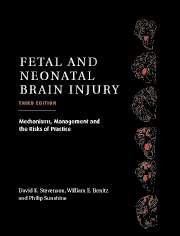Book contents
- Frontmatter
- Contents
- List of contributors
- Foreword
- Preface
- Part I Epidemiology, Pathophysiology, and Pathogenesis of Fetal and Neonatal Brain Injury
- Part II Pregnancy, Labor, and Delivery Complications Causing Brain Injury
- Part III Diagnosis of the Infant with Asphyxia
- 20 Clinical manifestations of hypoxic–ischemic encephalopathy
- 21 The use of the EEG in assessing acute and chronic brain damage in the newborn
- 22 Structural and functional imaging of hypoxic–ischemic injury (HII) in the fetal and neonatal brain
- 23 Near-infrared spectroscopy and imaging
- 24 Placental pathology and the etiology of fetal and neonatal brain injury
- 25 Correlations of clinical, laboratory, imaging and placental findings as to the timing of asphyxial events
- Part IV Specific Conditions Associated with Fetal and Neonatal Brain Injury
- Part V Management of the Depressed or Neurologically Dysfunctional Neonate
- Part VI Assessing the Outcome of the Asphyxiated Infant
- Index
- Plate section
24 - Placental pathology and the etiology of fetal and neonatal brain injury
from Part III - Diagnosis of the Infant with Asphyxia
Published online by Cambridge University Press: 10 November 2010
- Frontmatter
- Contents
- List of contributors
- Foreword
- Preface
- Part I Epidemiology, Pathophysiology, and Pathogenesis of Fetal and Neonatal Brain Injury
- Part II Pregnancy, Labor, and Delivery Complications Causing Brain Injury
- Part III Diagnosis of the Infant with Asphyxia
- 20 Clinical manifestations of hypoxic–ischemic encephalopathy
- 21 The use of the EEG in assessing acute and chronic brain damage in the newborn
- 22 Structural and functional imaging of hypoxic–ischemic injury (HII) in the fetal and neonatal brain
- 23 Near-infrared spectroscopy and imaging
- 24 Placental pathology and the etiology of fetal and neonatal brain injury
- 25 Correlations of clinical, laboratory, imaging and placental findings as to the timing of asphyxial events
- Part IV Specific Conditions Associated with Fetal and Neonatal Brain Injury
- Part V Management of the Depressed or Neurologically Dysfunctional Neonate
- Part VI Assessing the Outcome of the Asphyxiated Infant
- Index
- Plate section
Summary
Introduction
This article relates placental pathology to fetal and neonatal brain injury. In the author's experience, known causes of cerebral palsy have been substantially limited by deficient collaboration between clinicians, pathologists, epidemiologists, and basic scientists. Hence, in the following pages, there is advocacy for interdisciplinary investigations of neurologic and related disorders. The article is written by a pathologist who has practiced pediatric and placental pathology for more than 30 years and, including medicolegal consultations, has examined placentas from more than 450 cases of cerebral palsy. In reflection upon those experiences, there is no attempt to comment upon all relevant publications. Many more detailed aspects of the literature are provided in recent editions of Benirschke and Kaufmann, and of Fox, and there is convenient tabulated information in articles of Kaplan and colleagues and Langston and colleagues.
Clinical indications for placental examinations
Common sense should persuade one that any pregnancy which is sufficiently complicated to require “high-risk” management of the mother warrants sufficient concern to require gross and light microscopic placental examination. Similar consideration is applicable to the newborn. Indications for placental examination are provided in Table 24.1. This list, compiled by obstetricians, neonatologists, and pathologists, is a reasonable guideline for colleagues to use or modify.
Pathology reports
In many hospitals, placentas from uncomplicated deliveries are stored at 4 °C for 1 week in seven bins. If clinical problems occur, procurement of placentas for examination is thus facilitated. Examples of gross placental findings are provided in Table 24.2.
- Type
- Chapter
- Information
- Fetal and Neonatal Brain InjuryMechanisms, Management and the Risks of Practice, pp. 519 - 539Publisher: Cambridge University PressPrint publication year: 2003



